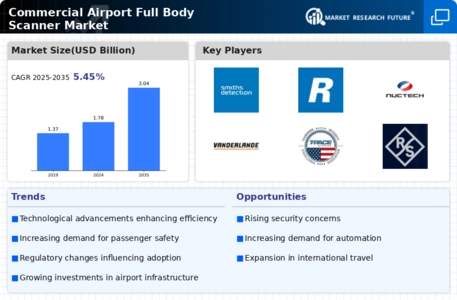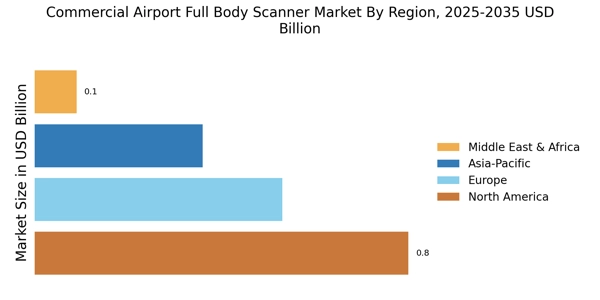The Commercial Airport Full Body Scanner Market is currently characterized by a dynamic competitive landscape, driven by technological advancements and increasing security demands. Key players such as Smiths Detection (GB), L3Harris Technologies (US), and Nuctech Company Limited (CN) are at the forefront, each adopting distinct strategies to enhance their market positioning. Smiths Detection (GB) focuses on innovation, particularly in developing advanced imaging technologies that improve detection capabilities. Meanwhile, L3Harris Technologies (US) emphasizes regional expansion, seeking to penetrate emerging markets with tailored solutions. Nuctech Company Limited (CN) appears to leverage partnerships with governmental agencies to bolster its market presence, indicating a strategic focus on compliance and regulatory alignment.
The market structure is moderately fragmented, with several players vying for market share through localized manufacturing and supply chain optimization. This fragmentation allows for a diverse range of products and services, catering to various customer needs. The collective influence of these key players shapes the competitive environment, as they continuously adapt to evolving security requirements and technological advancements.
In August 2025, Smiths Detection (GB) announced the launch of its latest full body scanner, which integrates artificial intelligence to enhance threat detection accuracy. This strategic move not only positions the company as a leader in innovation but also addresses the growing demand for more efficient security solutions in airports. The incorporation of AI is likely to set a new standard in the industry, compelling competitors to accelerate their own technological advancements.
In September 2025, L3Harris Technologies (US) secured a significant contract with a major international airport to supply its state-of-the-art full body scanners. This contract underscores the company's commitment to expanding its footprint in the global market. By aligning with high-profile clients, L3Harris Technologies enhances its credibility and visibility, which may lead to further opportunities in other regions.
In July 2025, Nuctech Company Limited (CN) entered into a strategic partnership with a leading airport security firm to co-develop next-generation scanning technologies. This collaboration is indicative of a broader trend towards innovation through partnerships, allowing Nuctech to leverage external expertise while enhancing its product offerings. Such alliances are likely to foster a more competitive environment, as companies seek to differentiate themselves through unique technological capabilities.
As of October 2025, the competitive trends in the Commercial Airport Full Body Scanner Market are increasingly defined by digitalization, sustainability, and the integration of artificial intelligence. Strategic alliances are becoming more prevalent, as companies recognize the value of collaboration in driving innovation. Looking ahead, the competitive differentiation is expected to evolve, shifting from traditional price-based competition to a focus on technological innovation, supply chain reliability, and enhanced customer experiences. This transition may redefine the market landscape, compelling companies to invest in cutting-edge technologies and sustainable practices to maintain their competitive edge.


















Leave a Comment